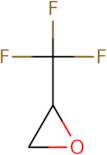3,3,3-Trifluoro-1,2-propenoxide
CAS: 359-41-1
Ref. 3D-FT168014
| 1g | Descatalogado | ||
| 2g | Descatalogado | ||
| 5g | Descatalogado | ||
| 10g | Descatalogado | ||
| 25g | Descatalogado |
Información del producto
- (2S)-2-(trifluoromethyl)oxirane
- (S)-2-(Trifluoromethyl)oxirane,Trifluoropropeneoxide
- (S)-3,3,3-Trifluoro-1,2-epoxypropane
- 1,1,1-Trifluoroheptan-2-Ol
- 1,1,1-trifluoro-N-hydroxy-N-(trifluoromethyl)methanamine
- 1,2-Epoxy-3,3,3-trifluoropropane
- 2-(Trifluoromethyl)Oxirane
- 2-Methyl-3-(Trifluoromethyl)Oxirane
- 2-Trifluoromethyloxirane
- 3,3,3-Trifluoro-1,2-Epoxypropane
- Ver más sinónimos
- 3,3,3-Trifluoropropene epoxide
- 3,3,3-Trifluoropropene oxide
- 3,3,3-Trifluoropropylene oxide
- Oxirane, (trifluoromethyl)-
- Oxirane, 2-(trifluoromethyl)-
- Propane, 2,3-epoxy-1,1,1-trifluoro-
- Trifluoroepoxypropane
- Trifluoromethyloxirane
- (S)-3,3,3-trifluoropropene oxide
Trifluoroacetic acid is a reactive molecule used in the synthesis of bioactive molecules. It is synthesized from 3,3,3-trifluoro-1,2-propenoxide by ring opening and nucleophilic attack on the carbonyl group. Trifluoroacetic acid reacts with an acid complex to form a salt and release water molecules. This salt can be isolated by evaporating the solvent. The active substances are obtained by hydrolysis of the salts with base or acid. Trifluoroacetic acid is also used as a cross-linking agent for proteins and other biomolecules. It has been shown to inhibit bacterial growth in vitro, which may be due to its ability to inhibit protein synthesis and cell division through inhibition of bacterial ribosomes.





